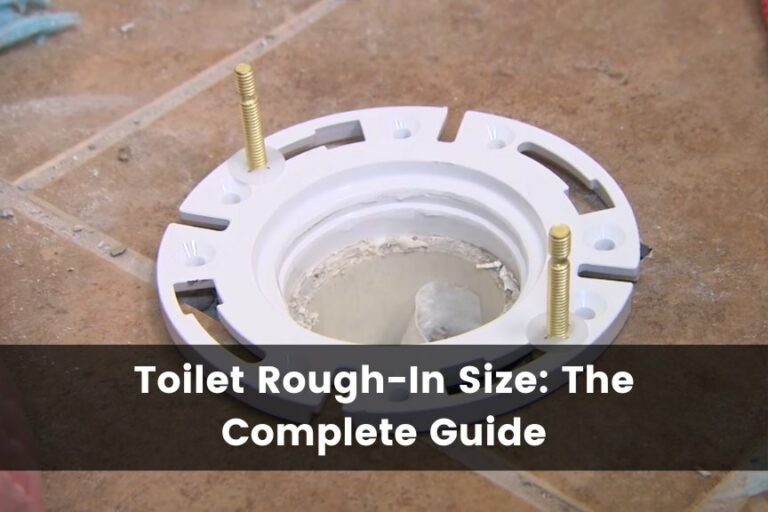Comfort Height vs Chair Height Toilet: Toilet Height Options Explained
Having a toilet with a slightly higher seat can work wonders to give people more independence, especially for those who struggle to use standard toilets. This is often overlooked, with most people concerned about things like shower safety, but the ability to comfortably use a toilet should be of equal concern. Comfort height toilets are ADA-approved and are higher than standard toilets.
Comfort height toilets, also known as chair height toilets, have raised seats to accommodate those with difficulty sitting and standing. For those who struggle to move from wheelchair to toilet, these can be a lifesaver. Comfort height toilets are up to 19 inches (48 cm) high.
Keep reading for more information on toilet height and the various options available to you. I’ll outline the pros and cons and explore the needs of different individuals. Finally, I will provide a quick buying guide.
Comfort vs. Chair Height: Different Terms, One Meaning
Comfort height toilets and chair-height toilets are the same product. There’s about 2 inches difference between a standard toilet and a comfortable height toilet, making life a lot simpler for those with disabilities or medical conditions, such as arthritis, that prevent them from moving around easily.
These toilets are relatively new to the market and aim to provide a greater level of comfort at home. Additionally, you might notice that older seats are rounded, whereas new seats are elongated for greater comfort.
If you’re remodeling, this difference in shape is significant—especially if your bathroom isn’t too big. Elongated toilets take up more floor space. Nonetheless, you can get a rounded toilet in the taller size (chair height), so be sure to shop around before you settle on a model.
Standard Height Toilets
Standard toilets are closer to the ground, sitting up to 15 inches (38 cm) from floor level. They are the most commonly available toilet seats as they are the older option found in most homes.
Here are a few pros and cons of standard toilets:
Pros
- Suitable for children and those with shorter stature.
- Comparatively better for healthy bowel movements.
- More widely available.
- There are more style options.
Most people won’t have much difficulty using a standard toilet, making it the usual choice for families without specific bathroom needs.
Cons
- Difficult to use for those with mobility issues.
- Does not add to property value.
Unless you or your loved ones have difficulty using a standard toilet, there aren’t many disadvantages to installing one. You’ll only need to consider a different toilet if one of your family members needs it.
Comfort/Chair Height Toilets
These are the taller toilets, which often comply with regulations outlined in the Americans with Disabilities Act. They are around 2 inches (approximately 5 cm) taller than standard toilets but can be both elongated and round.
Pros
- Easier to use for those with disabilities, medical conditions, elderly homeowners, or taller people.
- Increase property value.
- Increases level of independence for those with specific needs.
- Can be customizable depending on the manufacturer.
Cons
- Not suitable for small children and short people.
- Not as widely available as standard toilets.
- Makes bowel movements more difficult.
- If there are multiple family members in the household, it might be better to install a detachable toilet seat so everyone can use it easily.
If only one of your family members struggles to use the toilet, there’s not much point in installing a comfort height toilet if everyone else will end up struggling. You can purchase a detachable toilet seat on wheels instead since this ensures the situation works for everybody.
ADA-Compliant Toilets
To be certified as ADA-compliant, a toilet must meet a set of strict rules. The height requirement for ADA-compliant toilets is an additional 2-3” (5-7 cm). The following are some of the other requirements:
- Removable arms, which do not need tools for removal.
- Spacious bowl
- Raised toilet seat for easier standing/sitting.
Of course, for the bathroom or toilet stall to be ADA-compliant, there are many more rules. If you’re a homeowner looking to buy a toilet for personal use, these regulations aren’t very important. Use them as a guideline to keep elderly or disabled members of your family comfortable.
On the other hand, if you are a business owner in the market for toilets for commercial use or even use within a shared space (such as an office, restaurant, or hotel), you should follow the strict rules and regulations outlined in the ADA.
Why Some People Need Higher Toilets
The two-inch difference between standard and tallet oilers is not merely aesthetic. It can contribute to a significant increase in quality of life and overall independence.
If you (or anyone in your household) have any of the following conditions, you may want to consider getting a chair-height toilet.
- Arthritis: This is a condition affecting the joints that is common in elderly patients and those with autoimmune disorders. Sitting down or standing up becomes very difficult for arthritis patients. Using a taller seat is easier because they do not need to flex or extend their knee joints as much, putting less strain on them.
- Herniated disc: Also known as a slipped or bulging disc, this condition can affect patients of all ages. If the affected disc is in the lower back, sitting in a low toilet can be difficult when they are experiencing severe pain.
- Disabilities: Anyone with a disability that affects mobility or is wheelchair-bound should consider using a taller toilet seat because they can easily move from the wheelchair to the toilet and back, all on their own. Chair-height toilet seats are recommended by the ADA for this specific reason.
Ideally, a healthy individual should be able to squat all the way down to the ground. In reality, most Americans (or Westerners generally) are not comfortable squatting very low. These toilets make comfort their first priority.
Who Might Have a Problem Using Chair Height Toilets?
Chair-height toilets are not the right choice for everyone. Households with many children or people with shorter stature would not appreciate the difficulty getting onto a higher seat. For mixed families, a comfort height toilet can be problematic, so it’s best to consider each case individually.
Comfort height toilets are also known as universal height toilets, as they are the height of a universally standard dining chair. If you are unsure whether a comfort toilet is the right choice for your family, you can use a dining chair as a tester.
In other words, check if all household members can easily sit on a standard dining chair. If that’s the case, you can upgrade to a chair-height toilet without worries.
Additionally, if your reduced mobility is only due to a temporary injury, upgrading to a comfort height simply isn’t worth the trouble. In that case, you may consider getting a toilet seat riser or installing a toilet frame. I’ll explore those options below.
How To Increase Toilet Height
If you live in a household with mixed individuals, some needing taller toilets and others more comfortable on a standard seat, consider getting a standard toilet and increasing the height temporarily for some people.
Additionally, you might need a comfort height toilet but lack the budget to change it. If you live in a rented home, you might not be allowed to change the seat, and you might not be able to justify spending the money on a property that isn’t yours.
Here are a few ways you can increase toilet height.
Install an Elevated Toilet Seat
An elevated toilet seat replaces the existing seat with a higher seat. This means detaching the existing toilet seat (from the bolts) and replacing it with an elevated one. Of course, there are a wide variety of options available for elevated toilet seats, even at different heights.
Many elevated toilet seats also include handlebars on both sides of the toilet to make it easier for some people (such as the elderly) to get on or off the toilet.
One of the added advantages of this type of seat is that you can easily install a bidet, which is a spout within the toilet seat that people use as an alternative to wiping, reducing the need for toilet paper. It is considered more sanitary and eco-friendly.
There are also “fancy” and more techy options available, such as those with a seat warmer and a blow-drying function. If you’re looking for a great elevated toilet seat, I found the Carex 3.5 Inch Raised Toilet Seat (available on Amazon.com) easy to install. It has removable padded handles and supports up to 250 lbs (113.4 kg).
Toilet Frame
This option is very similar to a portable potty that small children can use during potty training. It is a frame that can be placed above your existing toilet to increase its overall height. Some models are adjustable, while others add a fixed height to your existing toilet.
Regardless of whether you get the adjustable or fixed-height toilet frames, check if the frame has an inner plastic lining. This will ensure that all the contents go to the toilet bowl instead of splattering on the old seat.
Otherwise, you’ll have a very hard time cleaning up. Keeping a clean toilet seat is important for sanitary reasons, so getting a toilet frame with an inner plastic lining should be non-negotiable.
Toilet Riser
You can install toilet risers underneath the toilet seat in your bathroom and fasten them with bolts the same way the original toilet seat is secured to the bowl. However, remember that toilet risers will weaken the structural integrity of the toilet seat, and they may not carry the same weight as before the risers were installed.
Since this option is an adjustment to your existing toilet seat, there are a wider variety of options available. You can adjust it to any height that suits you and your family.
This option will give you a taller toilet overall, which is considered a semi-permanent change you can make. However, I wouldn’t recommend installing toilet risers if you have shorter household members or children in your home because this option makes it difficult for them.
On the other hand, if you are renting and don’t want to spend the money to buy a new toilet, this is a perfect option for you.
Which Type of Toilet Is Better for Bowel Movements?
Standard toilets are better for bowel movement when compared to comfort-height toilets. However, squatting has been scientifically proven to be the best position for bowel movement without the risk of injuries.
In fact, defecating while sitting at a 45-degree angle has been associated with hemorrhoid development—a condition that affects more than half of Americans. Studies have shown that the ideal bowel movement is in the squatting position, which is why toilet stools were invented.
A toilet stool is a very short stool that is placed in front of a toilet to allow a person to lift up their legs while seated on the toilet. This position is optimal for most people and allows for easier bowel movements.
Nonetheless, chair-height toilets put you in a more seated position which is further away from squatting than sitting lower on a toilet seat. Still, if you feel more comfortable on a chair-height toilet, I would recommend getting one and investing in a toilet stool to help with bowel movements.
How To Buy the Right Toilet for Your Household
Given all the information mentioned in this article, it’s understandable if you’re overwhelmed and unsure which type of toilet is the best option for your household. Here are a few things to bear in mind when choosing a toilet for your family:
Measure Your Bathroom
First and foremost, you’ll need to measure your bathroom to ensure there is enough space to accommodate the toilet model you choose. You should account for the height of the toilet and bowl width and leave space for moving around when seated on the toilet.
If a disabled person uses the toilet, there should be even more space surrounding the toilet to accommodate a wheelchair if needed. The same amount of space should be included for elderly people.
Regarding toilet height, if you have a shelf above it, you should leave enough space for the average person to sit upright without banging their head on the shelf. You should also consider how spacious the bowl will be. The toilet bowl size may be particularly important if some of your household members have wide hips.
Choose Appropriate Height
With detailed measurements of your bathroom at hand, you can choose from the wide array of toilet height options available. Keep in mind that the comfort height and standard height are measurements describing the height from the floor to the rim only. With toilet risers or elevated toilet seats, the total height can increase significantly.
I recommend choosing chair-height toilets for most situations unless you have very small children or most people using the toilet are shorter than average. For elderly folks and those with disabilities, consider using a comfort height toilet with adjustments.
Adjustments To Consider
Consider whether you must install a variety of adjustments that can make sitting and standing from a toilet easier for elderly and disabled people. You may need to install seat elevators or handles to help people with their mobility.
Many of these adjustments also take up space, so make sure to account for them when taking measurements. For example, if you are getting a chair-height toilet, you may have space in the bathroom for it without adjustments only. Once you add a seat extender or handles, the space becomes too cramped.
I suggest allowing for extra space rather than being conservative with your measurements.
Other Factors
Besides toilet height, you should also consider the following factors when deciding which toilet to buy:
- Single/Dual Flushing: Older toilets only had one handle, which emptied the entire tank at once. Eco toilets allow for a weaker flush to avoid wasting water.
- Flushing Noise: A few toilets boast having a “quieter” flush, which can be a great addition to avoid waking up half your household every time you use the bathroom.
- Flushing Technology: Some models are marketed as a cleaner because of the way the water flushes downwards, keeping the bowl cleaner.
- Cost: Consider your budget before you commit to a purchase. Additionally, consider that a cheap model might break easily and so a more expensive model might be less costly over time.
- Color: While white toilets are the most popular, there are a few shades of cream or ivory that are also common. I don’t recommend choosing colored toilets because they decrease property value as they might not match every color palette.
- Fixtures: If you (or any household member) need fixtures to help with mobility, you should consider whether the toilet is compatible with standard fixtures such as removable handles.
Of course, there are also aesthetics to consider. This means checking whether the bowl has a concealed trapway, whether the overall shape of the toilet works well with your chosen interior design, etc.
Final Thoughts
Overall, a chair-height toilet is not only more comfortable for you and your family to use, but it will add to your property value in case you ever decide to sell. They are easier to use, and the installation of comfort and standard-height toilets is pretty much the same.
I recommend comfort-height toilets for anyone who can afford the option, especially for those with age-related movement disorders or disabilities.







